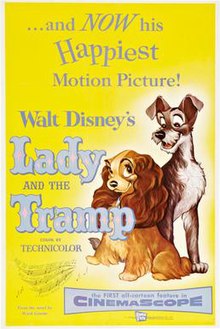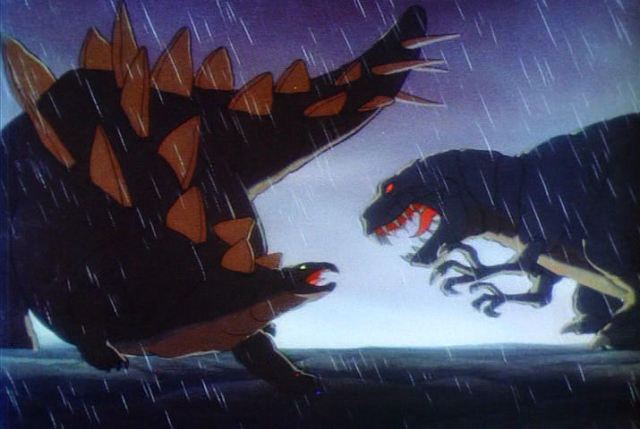
Peter Pan was Disney's 14th animated
movie. Based on the play by J. M. Barrie, Peter Pan tells the story of three
British children: Wendy, Michael, and John Darling. One night, a kid in green
clothes flew in through the window. He whisks the children away to Neverland, a
place where you never grow up. It was inhabited by mermaids, Native Americans,
a bunch of lost boys in animal costumes, and the notorious Captain Hook, who is
Peter's arch nemesis. Peter Pan isn't a masterpiece, but it is an enjoyable
piece of entertainment that only Disney could've made. The character Tinkerbell
became popular enough to have her own franchise.
29. The Land before Time (1988)

In the follow-up to An American
Tail, The Land before Time tells the story of a young Apatosaurus named
Littlefoot, whose mother got killed after a fight with a Tyrannosaurus Rex and
an earthquake. Her last words were "Do you remember the way to the great
valley?" Now on his own, Littlefoot must make it to the great valley to
find his grandparents. Along the way, he meets a Triceratops named Cera, a
Parasaurolophus named Ducky, a Pterodactyl named Petrie, and a Stegosaurus
named Spike. The Land before Time was one of the shortest animated movies
released during the 80s, having a running time of only 69 minutes. This is
because there were many scenes featuring Shaprtooth, the Tyrannosaurus.
Executive producers Steven Spielberg and George Lucas remarked that it was too
scary. "We'll have kids crying in the lobby and a lot of angry parents.
You don't want that." Anyway, The Land before Time earned over 70 million
dollars at the box-office, got great reviews, and spawned 12 direct-to-video
sequels, more sequels than any other animated feature.
28. Bambi (1942)

Based on the book by Felix Salten,
Bambi tells the story of a deer and the animals around him in the forest as he
grows to become a mighty stag. While the movie was developed to be less
hard-hitting than the book, it does contain some powerful emotional scenes,
including the infamous scene in which Bambi's mother gets killed by hunters. In
order to make Bambi believable, the animators studied real deer that were brought
into the studio, and a mini zoo was set up on site to study other animals.
Although Bambi got good reviews, it bombed at the box-office. It was released
right during the middle of WWII. Also, some people criticized the film for
making humans the antagonists. However, if Bambi were never made, there would
be no Land before Time, no Lion King, no DreamWork's Spirit, and no Finding
Nemo, because those films would also use extensive research on real animals.
27. Lady and the Tramp (1955)

This movie is more than just a love
story. It was the first animated feature to be released in Cinemascope, and the
first Disney feature to tell a 20th century, urban type of tale. Lady and the
Tramp tells the story of a cocker spaniel named Lady, who belongs to a human
named Jim. When Jim's wife gives birth to a baby boy, the baby steals Lady's attention, and Aunt Sarah brings Lady to the pet store to put a muzzle on her. Lady
escapes and meets the trouble-making Tramp, and together, they go on
misadventures involving a trip to the zoo, chasing chickens, and the famous
dinner scene at Tony's, the Italian restaurant. Lady and the Tramp was a
financial success and earned more money than any Disney feature since Snow
White. It is one of the best loved features from the studio, has a universal appeal that transcends all age groups, and has aged quite well..
26. Cinderella (1950)

Cinderella was Disney's first true
animated feature since Bambi in 1942, and their biggest success in a while.
Based on the version by Charles Perrault, Cinderella tells the story of a young
girl named Cinderella (Ilene Woods), who lives with the wicked Lady Tremaine
and her daughters Anastasia and Drizella. The only friends she has are mice
dressed up like dwarfs. Cinderella wants to go to the ball the Royal prince is
having, but Lady Tremaine and the Stepsisters keep giving her chores. Jaq and
Gus, two of Cinderella's mice, search the house for the items needed to find
the perfect dress. When presented to Lady Tremaine, Anastasia and Drizella
think Cindy stole their clothes. They rip apart the dress and Cinderella runs
into the garden crying. Upon hearing her crying, Cindy's Fairy Godmother
appears. She gives Cinderella a beautiful white dress, turns a pumpkin into a
wagon, turns four of the mice into horses, and Bruno, Cinderella's dog, into a
human (who doesn't speak when he turns into one). However, the Fairy Godmother
warns Cinderella that by midnight, the spell will ware off. The movie succeeds
because it remains faithful to the spirit of the original fairy tale while having
a Disney touch.
25. The Last Unicorn (1982)

Based on the book by Peter S Beagle,
this charming forgotten film from Rankin/Bass tells the story of a unicorn (Mia
Farrow) who, upon hearing that she is the last of her kind in the world, goes
on a quest to find the rest of her kind. The movie was originally going to be
distributed by Warner Bros, but when Ralph Bakshi's The Lord of the Rings
flopped at the box-office, Michael Chase Walker, who would become associate
producer, was sent back to square one. The project would eventually be picked
up by Jules Bass of Rankin/Bass, who had suggested The Last Unicorn as a
possible Rankin/Bass production. The movie was animated by Japanese animation
studio Topcraft, which would eventually become Studio Ghibli. The musical score
and songs were written by Jimmy Webb and sung by the band America. The Last
Unicorn premiered in November of 1982, but was unfortunately doomed by the
capriciousness of time and marketplace, as well as absolutely no marketing. The
movie would be forgotten until many years later when Mr. Walker was lecturing
at The College of Santa Fe, and was delighted to learn that so many of his
students declared 'Unicorn' as their favorite childhood film.
24. Mulan (1998)

Mulan was the first of three
animated Disney movies to come solely out of the Florida Studio. The story
concerns a Chinese woman named Mulan (Ming-Na Wen), who runs away from home to
dress up as a boy to join the army to serve in her elderly father's place.
Guided by the hilarious pint-sized dragon Mushu (Eddie Murphy), Mulan must
overcome her fears of failure and dishonor to save China. Mulan got
great reviews, but wasn't as successful at the box-office as previous hits like
Aladdin or The Lion King. To me, Mulan is a forgotten gem with brilliant
animation, a compelling story, catchy songs, and a brilliant score from the late Jerry
Goldsmith. Also, when's the last time you've seen a TERRORIST as a Disney
villain?
23. The Illusionist (2010)

Sylvain Chomet's The Illusionist is
a followup to his 2003 feature The Triplets of Belleville (see entry #13). The
story concerns an aging magician coming to the end of his career in the late
50s, the era that saw the birth of rock and roll and the death of music hall.
The story has its origins in an unproduced 50-year-old script by the legendary
French director and comic actor Jaques Tati. The original script was for a
live-action movie set in Czechoslovakia and starring Tati and his daughter
Sophie. Chomet tweaked the script so that the film looked more French, and
changed the daughter to a naïve small-town girl named Alice. Also, like
'Belleville', this movie used almost no dialogue. The Illusionist got nominated
for the Oscar for Best Animated Feature, but lost to another Pixar film, Toy
Story 3.
22. Fantasia (1940)

Fantasia started as a short called
The Sorcerer's Apprentice, starring a redesigned Mickey Mouse. Walt was pleased
by this, and decided it should be made into a feature film. The result:
Fantasia, Walt Disney's most experimental film he worked on. The music was
conducted by the legendary Leopold Stokowski and the Philadelphia Orchestra,
with classical music from legendary composers like Paul Dukas, Igor Stravinsky,
Ludwig van Beethoven, and Pyotr Tchaikovsky. The segments in Fantasia included:
•Toccata and Fugue in D Minor, in
which various colors and shapes bounced, swirled, and rocked to the beat of
Johann Sebastian Bach.


•The Nutcracker Suite, which didn't
feature any nutcrackers. Instead, it featured dancing flowers, fairies, and
mushrooms as the seasons change into one another.


•The Sorcerer's Apprentice, in which
Mickey Mouse is a wizard-in-training and uses his master's best magic tricks to
bring a broomstick to life to fill a cauldron up with water, with disastrous
consequences. This has become one of Mickey's most famous and memorable roles.


•Rite of Spring, an interpretation
of Earth's prehistory, from the birth of the planet to the extinction of the
dinosaurs. It's safe to call this segment a precursor to The Land before Time,
except the dinosaurs do not talk.


•The Pastoral Symphony, which
features a festival taking place with Greek gods, centaurs, fauns, and other
mythical creatures, which is interrupted by the god Zeus hurling lightning
bolts. This scene is controversial for the African appearance of the servant
centaurs.


•Dance of the Hours, a comedic
ballet featuring ostriches, hippos, elephants, and alligators.


•Night on Bald Mountain, in which
the demon Chermabog summons various monstrous creatures of the night. He brings
lost souls back to life just so he can kill them again.

The segment ends with the tolling of a bell and a procession of monks walking through a forest near the mountain of the accompaniment of Ave Maria.


The segment ends with the tolling of a bell and a procession of monks walking through a forest near the mountain of the accompaniment of Ave Maria.

Like Pinocchio, Fantasia originally
bombed at the box-office, but is now considered a classic, a masterpiece even.
21. The Secret of NIMH (1982)

In 1979, after spending nearly a
decade at Disney learning from the living legends of animation, Don Bluth, Gary
Goldman, and John Pomeroy set up Don Bluth Productions, later joined by eight
more artists. Bluth and his crew used techniques used by Disney during the
1940s, now often abandoned due to issues of time and expense. As well as the
highly traditional, full-quality character animation, more painstaking effort
was taken with novel visual techniques, like color Xerography and split
exposers and diffusion to create shadows, translucency, and reflections. There
was also a return to classic, Disney-style use of the multiplane camera.
Despite the care lavished on it, the film still only cost about half that of an
average Disney feature. Based on the children's book by Robert O'Brien, The
Secret of NIMH tells the story of a widow mouse named Mrs. Brisby (Elizabeth
Hartman), who must move out of her field because the plow is on its way, but
one of her children is sick. They escape with the help of super-intelligent
rats who have escaped from NIMH- the National Institute of Mental Health. Mrs.
Brisby repays the rats by saving them from extermination by NIMH with the aid
of a magic amulet. The Secret of NIMH got generally good reviews, but only
performed averagely at the box-office, partially due to having to compete
against Steven Spielberg's ET. Impressed by 'NIMH', Spielberg became executive
producer of Don Bluth's next film, An American Tail.
EDIT! 10-30-16: Swapped the places the Cinderella and Peter Pan.
EDIT! 10-30-16: Swapped the places the Cinderella and Peter Pan.
Interesting ranking and description as I would have Cinderella, Secret of Nimh and Fantasia much higher. I also didn't care for the Illusionist. The film keeps the lead character at a distance with mostly long shots and I found it hard to care for him because of that distance. Didnt work for me
ReplyDelete